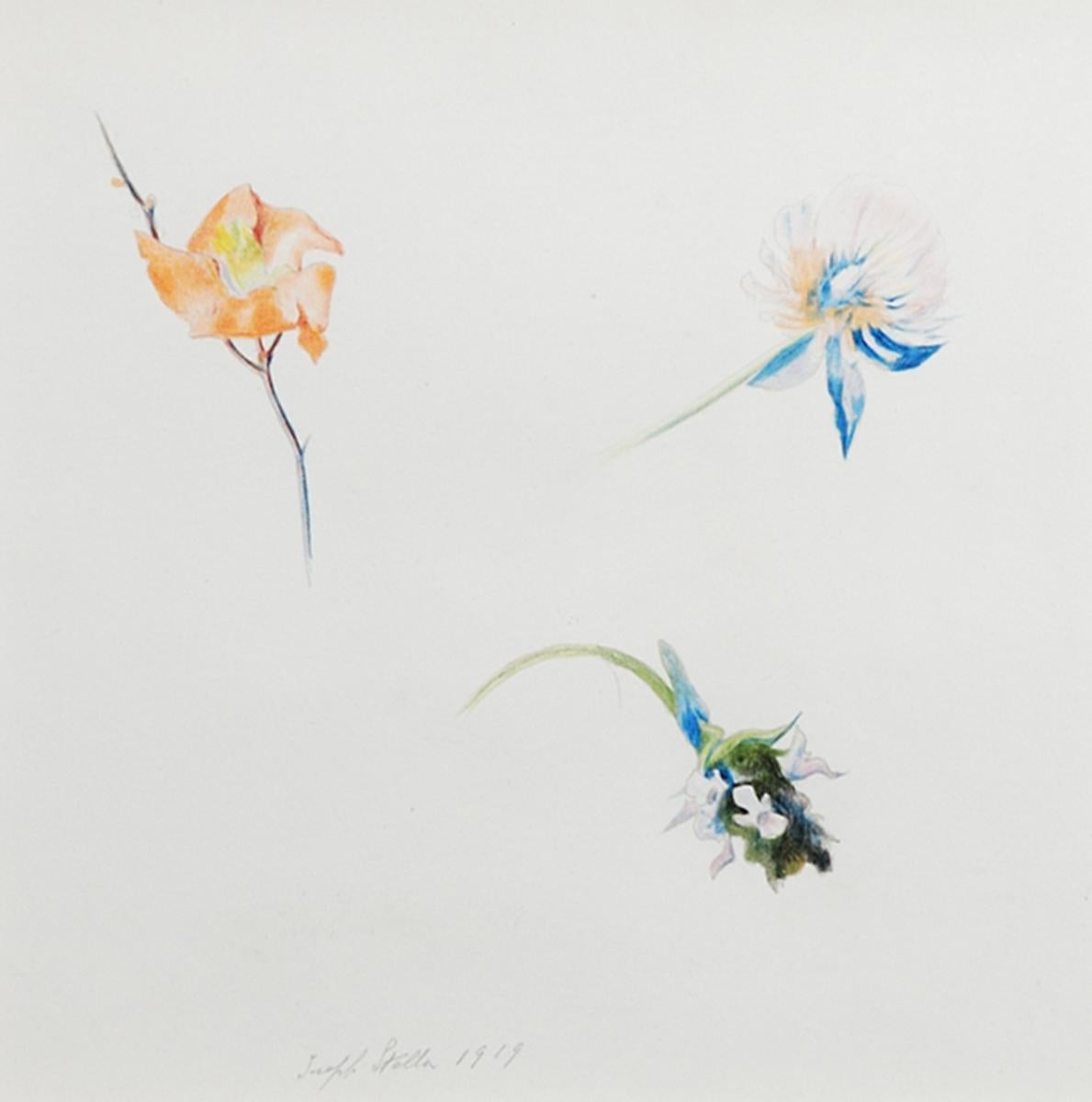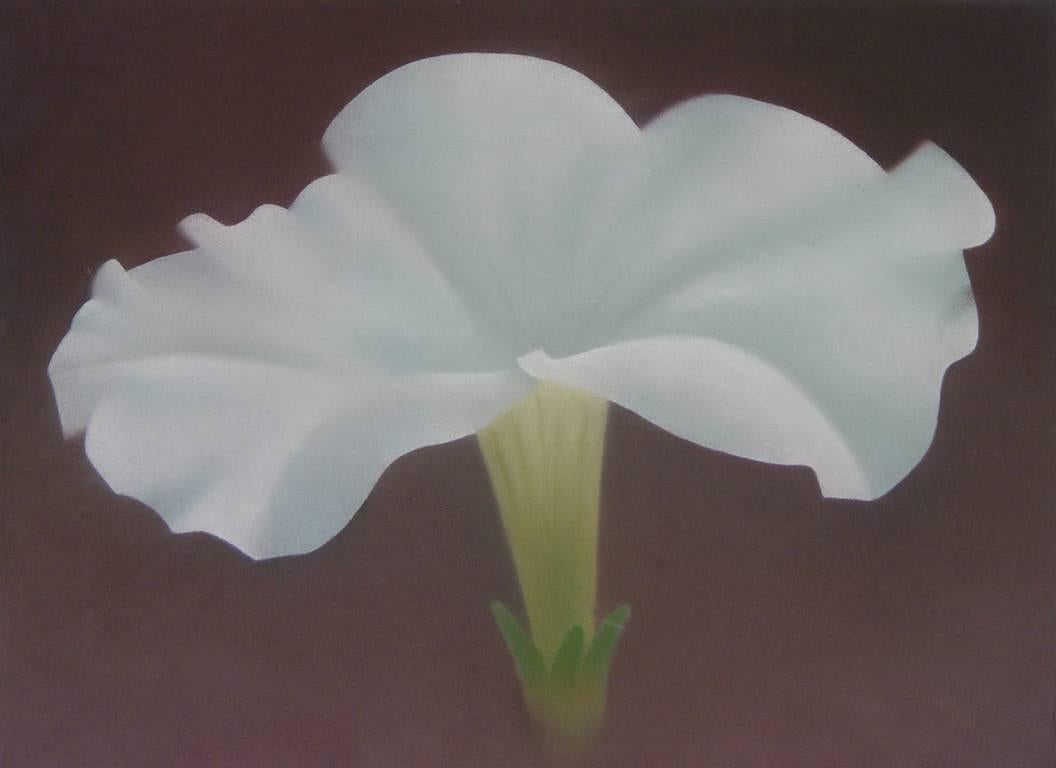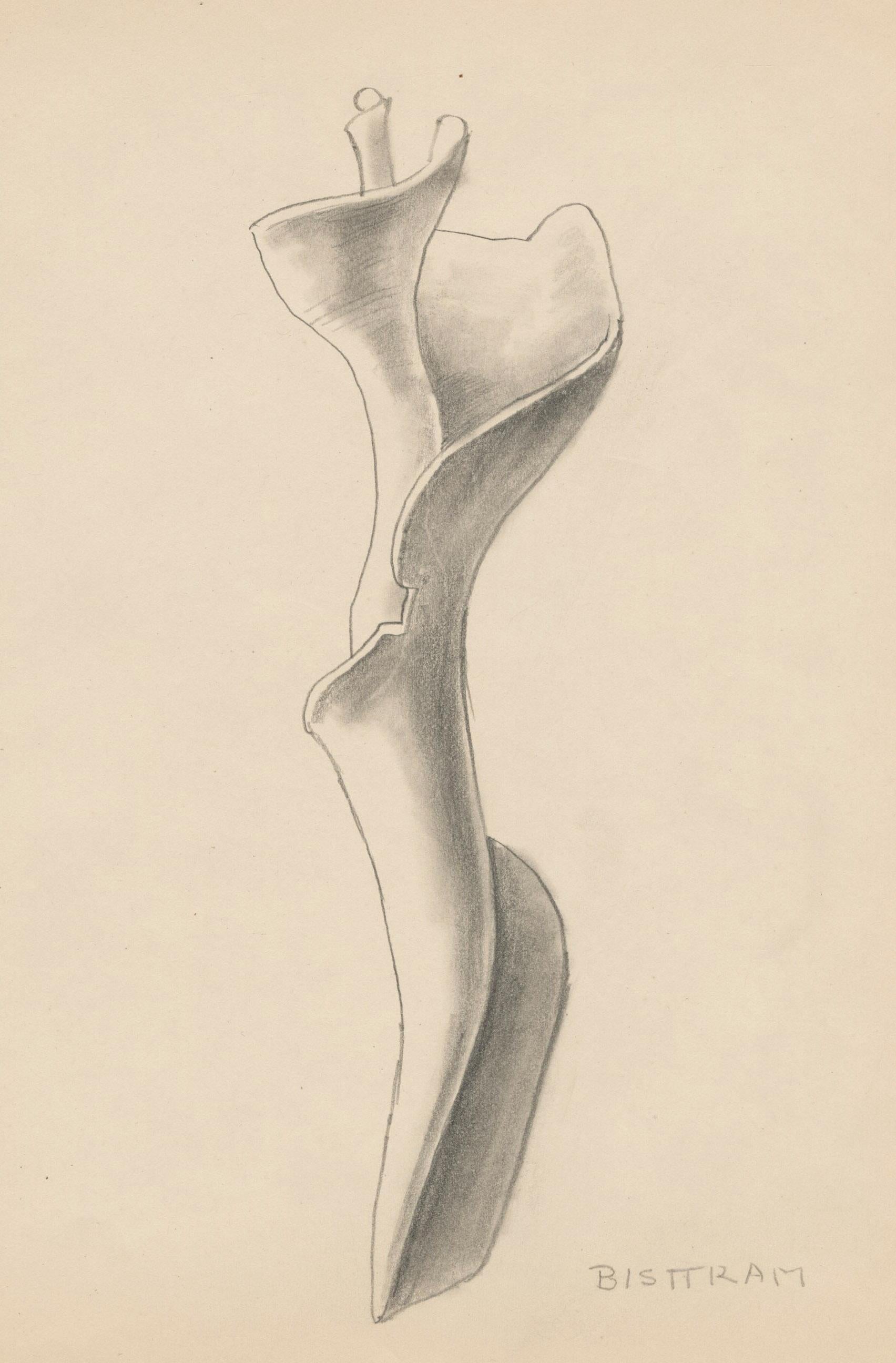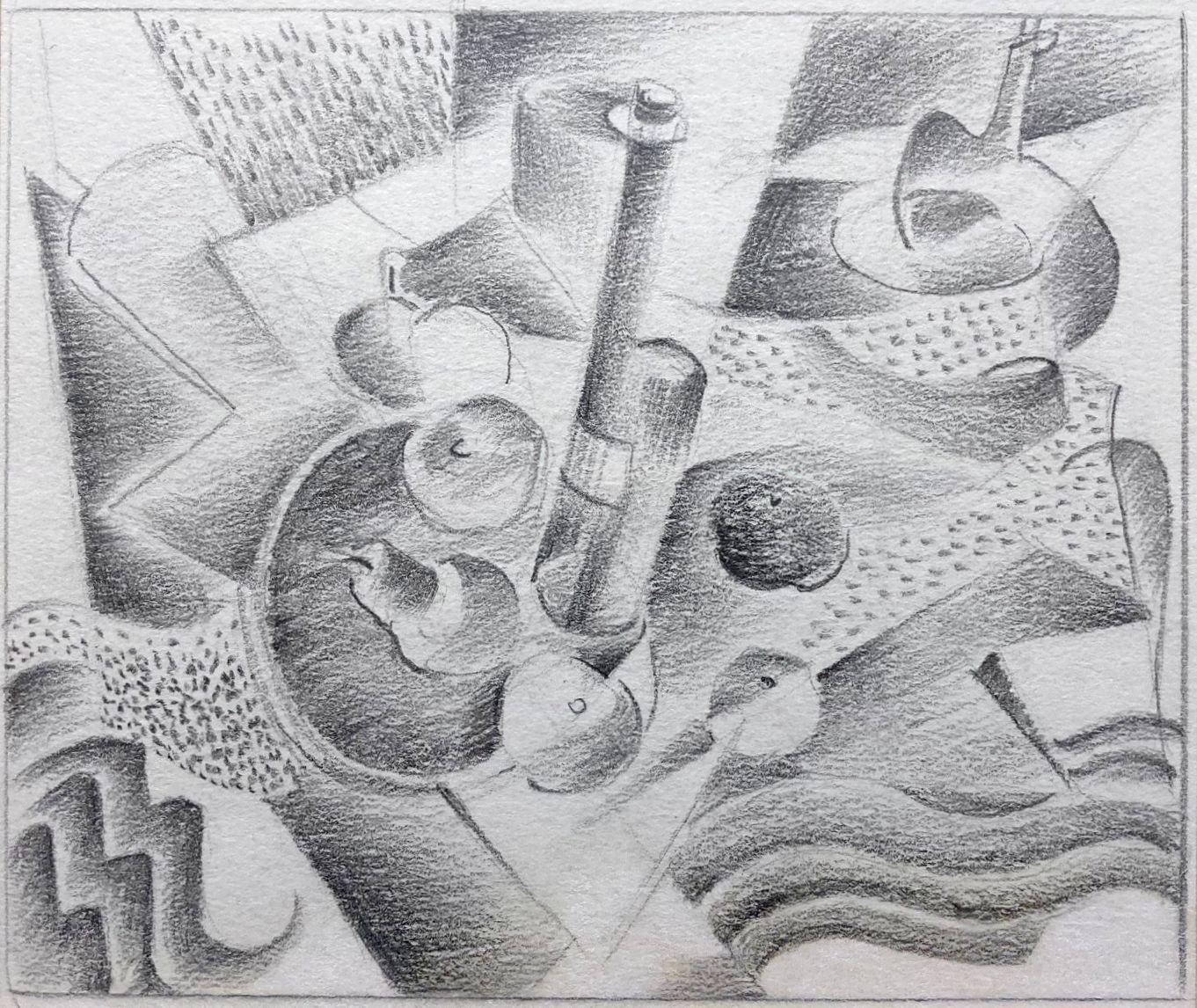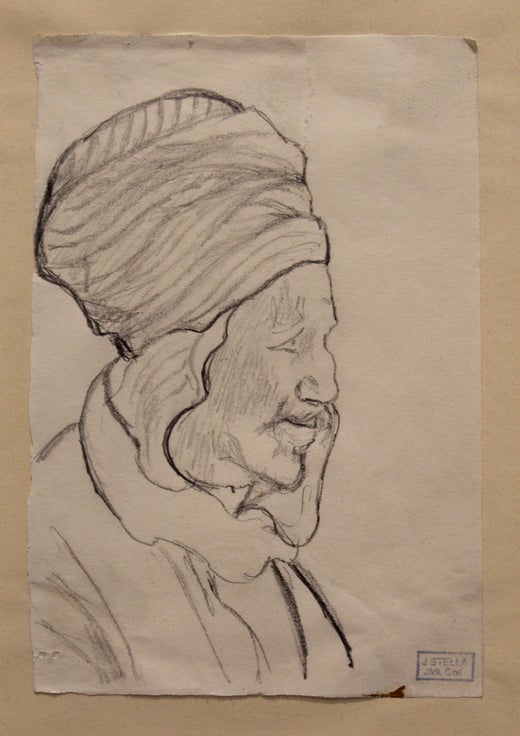Joseph StellaJoseph Stella Flower Study
About the Item
- Creator:Joseph Stella (1877-1946, American, Italian)
- Dimensions:Height: 12.5 in (31.75 cm)Width: 10 in (25.4 cm)Depth: 1 in (2.54 cm)
- Medium:
- Movement & Style:
- Period:
- Condition:Beautiful estate condition. Minor fading of paper.
- Gallery Location:Norwood, NJ
- Reference Number:1stDibs: LU2584213420802
Joseph Stella
Joseph Stella was a visionary artist who painted what he saw, an idiosyncratic and individual experience of his time and place. Stella arrived in New York in 1896, part of a wave of Italian immigrants from poverty-stricken Southern Italy. But Stella was not a child of poverty. His father was a notary and respected citizen in Muro Lucano, a small town in the southern Apennines. The five Stella brothers were all properly educated in Naples. Stella’s older brother, Antonio, was the first of the family to come to America. Antonio Stella trained as a physician in Italy, and was a successful and respected doctor in the Italian community centered in Greenwich Village. He sponsored and supported his younger brother, Joseph, first sending him to medical school in New York, then to study pharmacology, and then sustaining him through the early days of his artistic career. Antonio Stella specialized in the treatment of tuberculosis and was active in social reform circles. His connections were instrumental in Joseph Stella’s early commissions for illustrations in reform journals.
Joseph Stella, from the beginning, was an outsider. He was of the Italian-American community, but did not share its overwhelming poverty and general lack of education. He went back to Italy on several occasions, but was no longer an Italian. His art incorporated many influences. At various times his work echoed the concerns and techniques of the so-called Ashcan School, of New York Dada, of Futurism and, of Cubism, among others. These are all legitimate influences, but Stella never totally committed himself to any group. He was a convivial, but ultimately solitary figure, with a lifelong mistrust of any authority external to his own personal mandate. He was in Europe during the time that Alfred Stieglitz established his 291 Gallery. When Stella returned he joined the international coterie of artists who gathered at the West Side apartment of the art patron Conrad Arensberg. It was here that Stella became close friends with Marcel Duchamp.
Stella was 19 when he arrived in America and studied in the early years of the century at the Art Students League, and with William Merritt Chase, under whose tutelage he received rigorous training as a draftsman. His love of line, and his mastery of its techniques, is apparent early in his career in the illustrations he made for various social reform journals. Stella, whose later work as a colorist is breathtakingly lush, never felt obliged to choose between line and color. He drew throughout his career, and unlike other modernists, whose work evolved inexorably to more and more abstract form, Stella freely reverted to earlier realist modes of representation whenever it suited him. This was because, in fact, his “realist” work was not “true to nature,” but true to Stella’s own unique interpretation. Stella began to draw flowers, vegetables, butterflies, and birds in 1919, after he had finished the Brooklyn Bridge series of paintings, which are probably his best-known works. These drawings of flora and fauna were initially coincidental with his fantastical, nostalgic and spiritual vision of his native Italy which he called Tree of My Life (Mr. and Mrs. Barney A. Ebsworth Foundation and Windsor, Inc., St. Louis, illus. in Barbara Haskell, Joseph Stella, exh. cat. [New York: Whitney Museum of American Art, 1994], p. 111 no. 133).
(Biography provided by Hirschl & Adler)
- ShippingRetrieving quote...Ships From: Norwood, NJ
- Return PolicyA return for this item may be initiated within 3 days of delivery.
- Kneeling Female Nude, Bronze By Mario KorbelLocated in Norwood, NJJoseph Mario Korbel (Czech/American, 1882-1954). Period fine example bronze, dark brown patina, modeled as a nude female kneeling and tying her sandal, raised on a stepped black marb...Category
Early 20th Century Art Deco Figurative Sculptures
MaterialsMarble, Bronze
- Family Of Lions Bronze By Paul Édouard DelabrierreBy Paul Edouard DelabriereLocated in Norwood, NJA family of lions having green patination depicting a male lion feeding two cubs; mounted on a naturalistic base - signed and applied entitled plaque "Lion 1st Gibier" Paul Edouard Delabrierre...Category
Late 19th Century Figurative Sculptures
MaterialsBronze
- Art Deco Female Nude By George J. IllianLocated in Norwood, NJFemale nude by George John Illian (1894-1932), American exhibited at the Salmagundi Club Annual Exhibition. George John Illian born in 1894 and was largely inspired by the 1900s and ...Category
Early 20th Century Art Deco Nude Paintings
MaterialsOil
- "Forest Eyes" By Jon CarsmanBy Jon CarsmanLocated in Norwood, NJ"Forest Eyes" By Jon Carsman. Acrylic on canvas, 1974. Signed, dated and titled on verso. Maintaining original gallery label from Graham Gallery, Madison Ave. New York Biography: Jon...Category
Late 20th Century American Realist Landscape Paintings
MaterialsAcrylic
- "Night At The Lake" By Maud GatewoodLocated in Norwood, NJMaud Florance Gatewood (1934-2004) American. Fine example of her work, "Night at the Lake" is polymer on cut board, having the artist original identification card from the 20th Irene Leache MemorialBiennial Exhibition, 1970. Signed and dated lower Right MFG 69. Gatewood was arguably the most important living North Carolina painter and considered by art historians, curators, museum directors and collectors as one of the most important painters in North Carolina history. Maud Gatewood's artwork is familiar to museum-goers throughout the South. She has been a prominent figure throughout the southeastern United States during her 55-year career. An astute student, her interest in art began as a youngster in her hometown of Yanceyville, NC, studying then in 1945 at Averett College in nearby Danville, VA. At the age of 16, after having skipped two grades of school, she entered what is now the University of North Carolina at Greensboro where she received her B.A. in fine arts in 1954. One year later, she received her M.A. in painting from Ohio State University. She continued her education as an instructor beginning in 1956 at Huntingdon College in Montgomery, AL, and then at Texas Christian University in Fort Worth, TX. She then received a Fullbright Grant to study art history and painting at the Akademie Fur Angewandte Kunst and an extended Fullbright to study with Oskar Kokoschka in Salzburg, Austria. Her educational years were interspersed with traveling the world, that was the beginning of a life-long penchant, even at her death she was planning her next trip. In 1964, she returned to the U.S. where she joined the faculty of the University of North Carolina at Charlotte and served as founding head of the university art department. She then went on to teach at Central Piedmont Community College before returning to her home, Caswell County, where she was a professor for many years at Averett University. During her academic career, she also served as a visiting professor and artist at the University of Cincinnati, Davidson College, and the State University of New York, Oswego. Ms. Gatewood was honored by her alma mater, the University of North Carolina at Greensboro, with an honorary Doctorate in Fine Arts in 1999. On her life's path of discovery in painting, Ms. Gatewood was awarded the North Carolina Federation of Women's Club Scholarship in 1953; a painting award from the American Academy of Arts and Letters, National Institute of Arts and Letters in 1972; the North Carolina Arts Council Artist Fellowship in 1980; the Southeastern Center for Contemporary Art NEAA Grant 1981; the prestigious North Carolina Award in Fine Arts (Governor's Award) in 1984; the North Carolina Poster Award Commission for the U.S. Olympic Festival in 1987 and in 1993 she represented North Carolina in the Absolute statehood campaign featured in USA Today and Newsweek. She exhibited widely in the Southeastern United States and was honored with a retrospective exhibition covering 40 years of painting, organized by the Weatherspoon Gallery of Art at UNC-G in Greensboro, NC. The exhibition toured from 1994-95 in what is now the Cameron Museum of Art in Wilmington, NC as well as the Asheville Art Museum in Asheville, NC; Albany Museum of Art in Albany, GA and the Gallery of Art and Design at NC State University in Raleigh, NC. She represented the State of North Carolina in the exhibition Nine from North Carolina the National Museum of Women in the Arts in Washington, DC in 1989. She was also featured in the 1988 Biannual at the Mint Museum of Art in Charlotte, NC; the Southern Arts Federation exhibition tour, Three Approaches to the Figurative, 1986; a drawing exhibition at the Knight Gallery at Spirit Square in Charlotte in 1989; an exhibition at the Greenville Museum of Art in Greenville, SC in 1984 featuring Ten Years - Ten Artists; Greenhill Center for North Carolina Arts in Greensboro, NC in 1984; Painting in the South the Virginia Museum, Richmond, VA 1983-85 and a touring exhibition at the North Carolina Museum of Art in 1983. One of North Carolina's most collected and sought after artists, Maud Gatewood's public collections include BB&T, Charlotte, NC; Baltimore Gas and Electric Company, Baltimore, MD; Burroughs-Wellcome Fund, RTP, NC; Coca-Cola, Atlanta, GA; Nasher Art Museum at Duke University, Durham, NC; Emory University, Atlanta, GA; Fayetteville Museum of Art, Fayetteville, NC; First Union Bank, Charlotte, NC; Smith-Kline Glaxo, RTP, NC; Hunter Museum, Chattanooga, TN; IBM Corporation, Charlotte, NC; Miller Brewing Company, Eden, NC; Mint Museum of Art, Charlotte, NC; National Collection of Fine Arts, Washington, DC; National Gallery for Women in the Arts, Washington, DC; Nations Bank, N.A., Charlotte, Raleigh and Winston-Salem, NC; Philip Morris Company, New York, NY; RJ Reynolds Tobacco Company, Winston-Salem, NC; Sprint, Wake Forest, NC; Kenan-Flagler School of Business, UNC-Chapel Hill, NC; Breakers Hotel...Category
Late 20th Century Landscape Paintings
MaterialsBoard, Polymer
- Stainless Steel Sculpture "Two Forms" By Roy GussowLocated in Norwood, NJPolished stainless steel abstract sculpture, "Two Forms" by Roy Gussow (American, 1918-2011), marked and dated with coin seal inlaid to marble base. Similar...Category
Mid-20th Century Abstract Geometric Abstract Sculptures
MaterialsGranite, Stainless Steel
- Three FlowersBy Joseph StellaLocated in New York, NYJoseph Stella was a visionary artist who painted what he saw, an idiosyncratic and individual experience of his time and place. Stella arrived in New York in 1896, part of a wave of ...Category
20th Century American Modern Still-life Drawings and Watercolors
MaterialsPaper, Crayon
- FlowerBy Robert PetersonLocated in Dallas, TXsigned at lower leftCategory
20th Century American Modern Still-life Drawings and Watercolors
MaterialsPastel, Paper
- Two Wood Ducks on a Flowering BranchBy Joseph StellaLocated in New York, NYJoseph Stella was a visionary artist who painted what he saw, an idiosyncratic and individual experience of his time and place. Stella arrived in New York in 1896, part of a wave of Italian immigrants from poverty-stricken Southern Italy. But Stella was not a child of poverty. His father was a notary and respected citizen in Muro Locano, a small town in the southern Appenines. The five Stella brothers were all properly educated in Naples. Stella’s older brother, Antonio, was the first of the family to come to America. Antonio Stella trained as a physician in Italy, and was a successful and respected doctor in the Italian community centered in Greenwich Village. He sponsored and supported his younger brother, Joseph, first sending him to medical school in New York, then to study pharmacology, and then sustaining him through the early days of his artistic career. Antonio Stella specialized in the treatment of tuberculosis and was active in social reform circles. His connections were instrumental in Joseph Stella’s early commissions for illustrations in reform journals. Joseph Stella, from the beginning, was an outsider. He was of the Italian-American community, but did not share its overwhelming poverty and general lack of education. He went back to Italy on several occasions, but was no longer an Italian. His art incorporated many influences. At various times his work echoed the concerns and techniques of the so-called Ashcan School, of New York Dada, of Futurism and, of Cubism, among others. These are all legitimate influences, but Stella never totally committed himself to any group. He was a convivial, but ultimately solitary figure, with a lifelong mistrust of any authority external to his own personal mandate. He was in Europe during the time that Alfred Stieglitz established his 291 Gallery. When Stella returned he joined the international coterie of artists who gathered at the West Side apartment of the art patron Conrad Arensberg. It was here that Stella became close friends with Marcel Duchamp. Stella was nineteen when he arrived in America and studied in the early years of the century at the Art Students League, and with William Merritt Chase, under whose tutelage he received rigorous training as a draftsman. His love of line, and his mastery of its techniques, is apparent early in his career in the illustrations he made for various social reform journals. Stella, whose later work as a colorist is breathtakingly lush, never felt obliged to choose between line and color. He drew throughout his career, and unlike other modernists, whose work evolved inexorably to more and more abstract form, Stella freely reverted to earlier realist modes of representation whenever it suited him. This was because, in fact, his “realist” work was not “true to nature,” but true to Stella’s own unique interpretation. Stella began to draw flowers, vegetables, butterflies, and birds in 1919, after he had finished the Brooklyn Bridge series of paintings, which are probably his best-known works. These drawings of flora and fauna were initially coincidental with his fantastical, nostalgic and spiritual vision of his native Italy which he called Tree of My Life (Mr. and Mrs. Barney A. Ebsworth Foundation and Windsor, Inc., St. Louis, illus. in Barbara Haskell, Joseph Stella, exh. cat. [New York: Whitney Museum of American Art, 1994], p. 111 no. 133). Two Wood Ducks...Category
20th Century American Modern Still-life Drawings and Watercolors
MaterialsColor Pencil
- Untitled, Still Life of ShellLocated in Fairlawn, OHUntitled, Still Life of Shell Graphite on paper, 1945-1951 Signed lower right in pencil "Bisttram" (see photo) Condition: Excellent Sheet size: 9.63 x 7 .5 inches EMIL BISTTRAM (189...Category
1940s American Modern Still-life Drawings and Watercolors
MaterialsGraphite
- Still LifeBy Stanley BieleckyLocated in Chicago, ILA Cubist black & white graphite drawing of fruit by artist Illinois and Michigan artist Stanley Bielecky.Category
1940s American Modern Drawings and Watercolor Paintings
MaterialsGraphite
- Untitled (Study of Classical Drapery)By Jan MatulkaLocated in Chicago, ILA graphite on paper, study of a classical drapery by artist Jan Matulka. The image is drawn on the back of a typewritten, folded sheet of stationery, from Dyer, Hudson & Co., New Yo...Category
1930s American Modern Still-life Drawings and Watercolors
MaterialsPaper, Graphite
